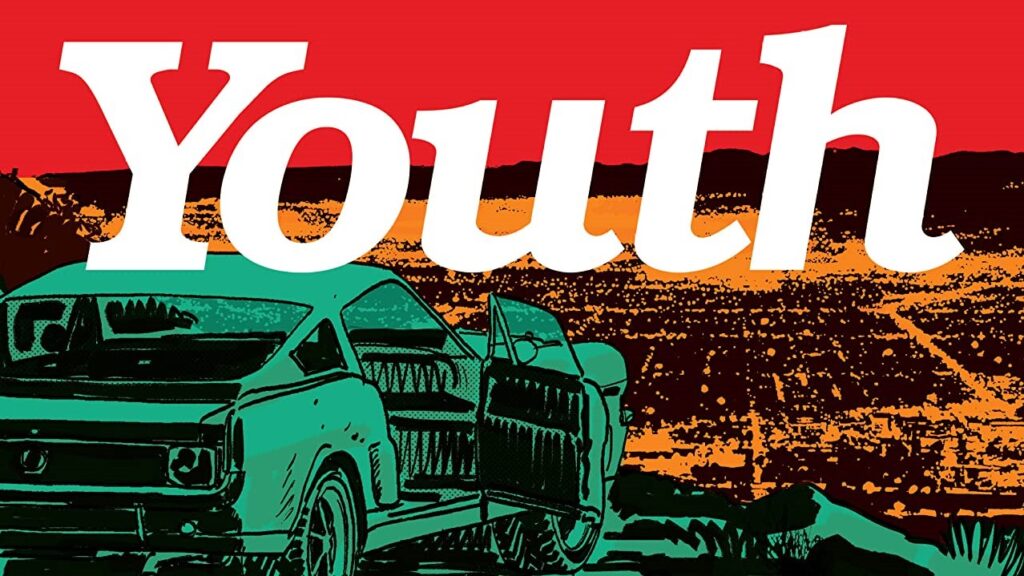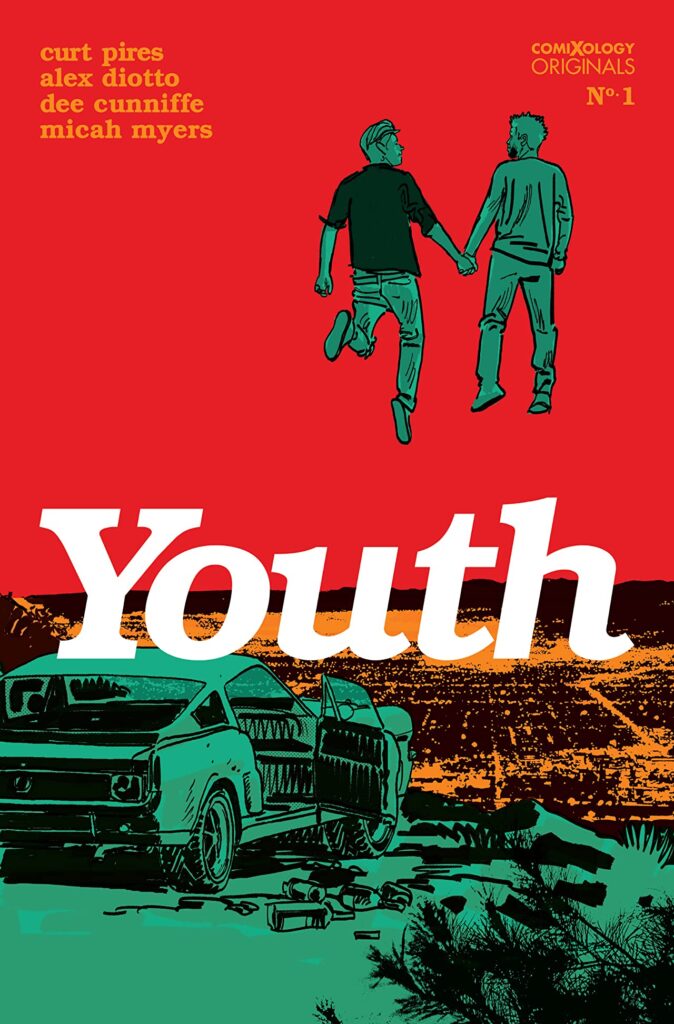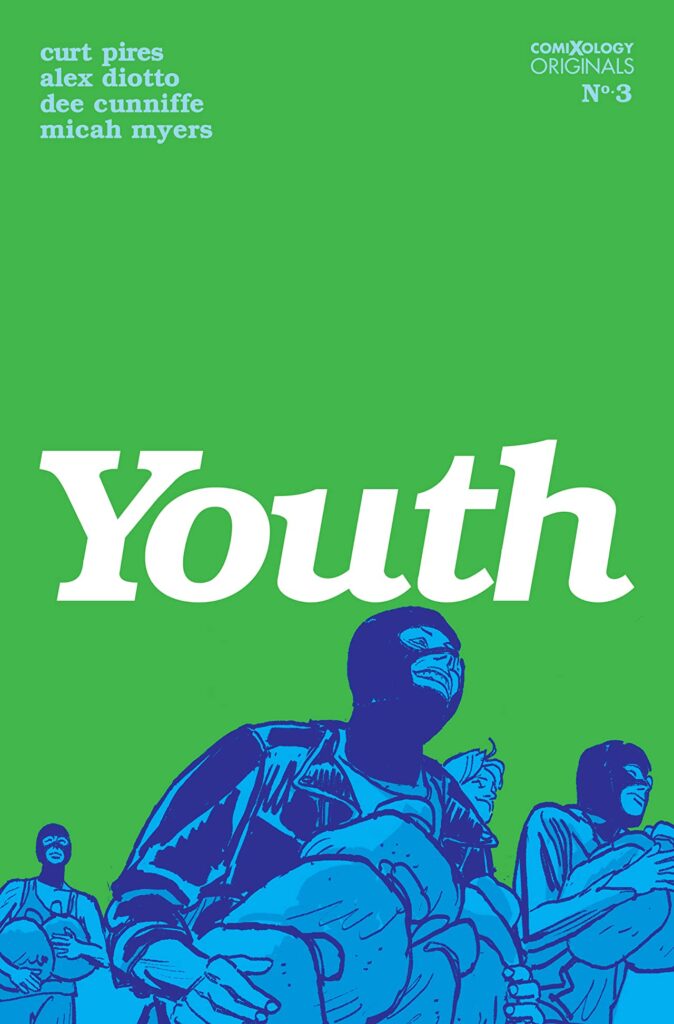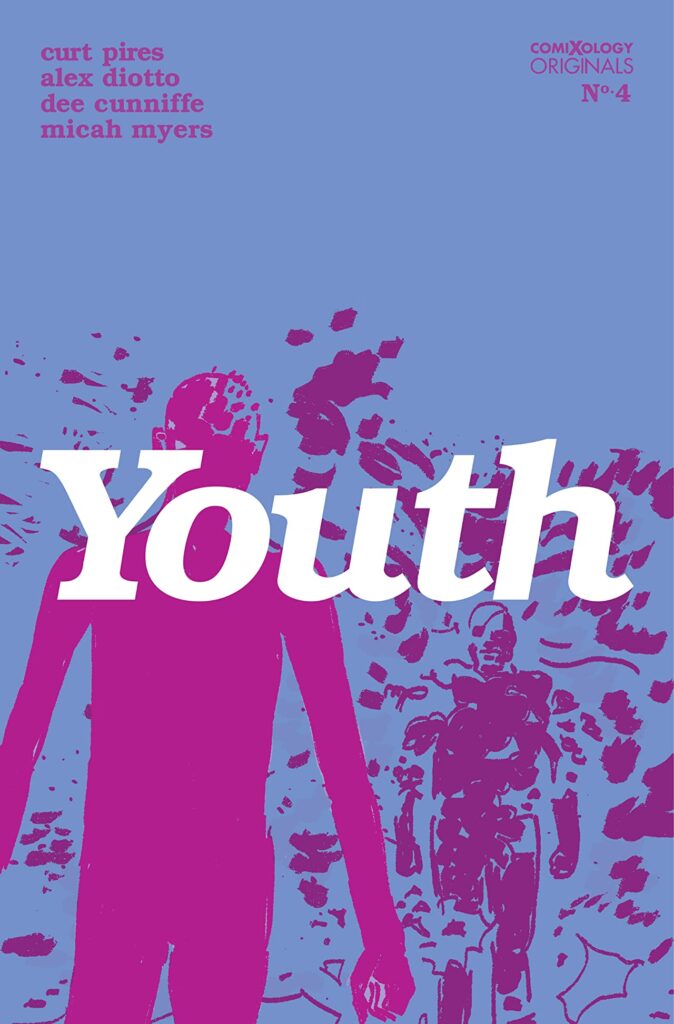
Comics Corner – Don’t Let Youth Pass You By
If you’re a reader who seeks out LGBTQ+ representation in comics, there’s one recent title that does it better than most – but it may have escaped your notice. You won’t find issues in your local comic shop, and you won’t be able to pick up a trade paperback collection from a bookshop or online. Instead, Youth is exclusive to ComiXology, the digital comic book platform that has, since 2014, been owned by Amazon.
The series, written by Curt Pires, with art by Alex Diotto, colour art by Dee Cunniffe, and letters by Micah Myers, follows Frank and River, two young men trapped in a small town, desperate for their lives to start. Frank is stuck in a dead end job, while River feels like a prisoner in his mother’s home, constantly butting heads with his loathed step-father. The pair find some small solace in each other though and, faced with no prospects and no reason to stay put, they steal River’s step-father’s car and head to California, dreams of a new life in their heads.

Youth isn’t a teen love story though. If anything, it’s closer to a lust story, perfectly capturing the messy, wild, emotionally fraught entanglements that come with growing up. Labels are typically rejected, characters experiment – with each other as well as a host of questionable substances – and relationships typically lead to betrayal, forgiveness, and more betrayal. As Frank and River’s small world expands when they meet fellow would-be rebels Kurt, Trixy, and Jan, affairs get uglier and more dramatic – and that’s before half the cast get superpowers when a meteorite crashes into them.
That tinge of the unexpected is what really elevates Youth beyond being merely a coming-of-age road trip. There’s a sense anything can happen, at any point – be it in how the characters relate to one another, to what they do with their newfound powers. But just as it’s not a love story, neither is this a super hero story. The first thing a group of disenfranchised group of teens who’ve never known independence or agency do when they learn they have powers is try to improve their own lives – but by taking the short route, with an attempt to rob an armoured truck. Like so much in these characters’ lives, it goes horribly wrong.

Through it all though, the relationship between Frank and River remains the lodestone for the whole story. They’re not in love – not really, maybe they think they are, maybe it’s something close to it, maybe they’re just each other’s life preserver – but that raw jumble of emotions brings every scene to greater life. Even as Frank questions whether he’s really gay, fooling around with Trixy, River’s confused, angry response seems to reflect his own conflicted feelings. Frank and River’s relationship is powerfully relatable for many queer readers, deftly capturing the awkwardness and uncertainty of first same-sex experiences, and the tricky task of uncovering who you are.
Youth is an incredibly genre-savvy work too. Pires’ script lampshades its influences before the reader can call them out, from River being named after River Phoenix in-story, nodding to the late actor’s standing in teen rebellion movies, to Don Thunder, leader of the shadowy government operation hunting down the newly empowered teens, being referred to as a “Bootleg Nick Fury”. The four-issue series serves as something of a “first season” for a planned larger work, with hints that the expansion of super powers will have wider, world-changing ramifications to come, tapping into a similar mythos as the X-Men or series such as Heroes.

Yet beyond its nods to wider pop culture, Youth itself is simply cool, in and of itself. Beyond the teen rebellion aspects – which could so easily feel trite and forced, yet here ring true – it’s a book of assured self-confidence. It knows exactly what story it wants to tell, and how it wants to subvert expectations for those types of stories, and proceeds at breakneck pace. A too-cool playlist is even seeded through the issues, populated by a mix of mainstream artists, classical music, and performers so hipster you’ll probably have to websearch them.
It’s also visually incredible. Diotto and Cunniffe seem to be working almost symbiotically here, with the latter’s colour art perfectly complementing the composition and layout of the former. The cover to the first issue, as seen above, is particularly brilliant, with the line of mountains in the distance creating a sort of panel break, so the reader at first glance thinks the image of River and Frank at the top is just them walking. It’s only after reading the story that you realise they’re flying above the car, the block of red a fierce sunset dominating the night sky. It’s incredibly striking, and such genius is common throughout the series.

Another reason you might want to be checking out Youth now is to be ahead of the curve. The series has already been optioned for development as a TV show by Amazon Studios. Amazon Prime Video has already become something of a streaming home for comic book adaptations, with the likes of The Tick, The Boys, and The Walking Dead populating the service, and Youth would be a perfect fit.
Although there’s a corporate edge to the move – taking a property debuting on one Amazon-owned platform, ComiXology, and developing it for another, Prime Video – the TV series has Pires attached to adapt. If whatever reaches screens has the same energy, bravery, and coolness of the comic, it’s going to be must-see TV. Read this now, so you can say you were into it before it was cool.







